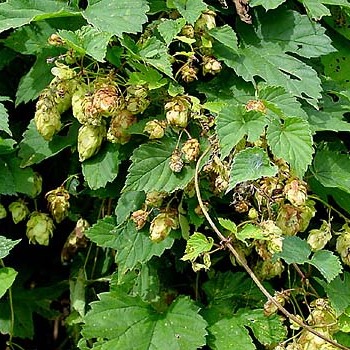Herbs , taprooted annuals or rhizomatous perennials, rightward-twining. Stems usually branched, armed with rigid 2-branched, stalked hairs that facilitate climbing. Leaves simple; petioles often twining, with 2-branched hairs. Leaf blade mostly cordate, palmately lobed, sometimes unlobed; surfaces abaxially resin-dotted and×or gland-dotted. Inflorescences: staminate inflorescences axillary and terminal, cymose panicles, erect to pendent, (10-)20-100+-flowered, flowers small; pistillate axillary, spikes or racemes, flowers solitary or paired, short-pedicellate, subtended by bracts and bracteoles. Staminate and pistillate flowers usually on different plants. Achenes lenticular or terete, ensheathed by brownish or sometimes mottled persistent perianth; embryo coiled. x = 10.
Dioecious; pistillate fls in short spikes, paired, each pair subtended by a foliaceous bract; ovary enclosed by the membranous, lobeless cal; fr an achene enclosed in the persistent cal and covered by the accrescent bracts; twining, herbaceous, perennial vines with rough stems and broad, opposite, usually lobed lvs. 3, N. Temp.
Scandent perennials. Lvs opposite, 5-7-nerved from the base, cordate and undivided or 3-7-lobed, serrate. Infls pendulous; ♀ infl. spicate, cone-like at fruiting, with broad, membranous, persistent, laxly imbricate bracts. Achene covered by the persistent, often glandular calyx; embryo spirally involuted; cotyledons narrow.
Annual or perennial twining climbers, dioecious. Stems terete, glabrous, or scabrous when young. Leaves opposite, ovate-cordate, usually 3–5-lobed. Inflorescences pendent; male much-branched; female lax, cone-like.

